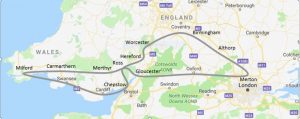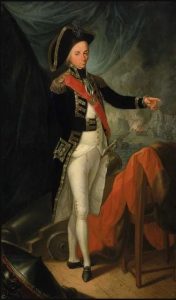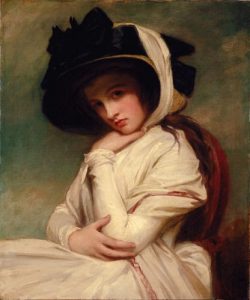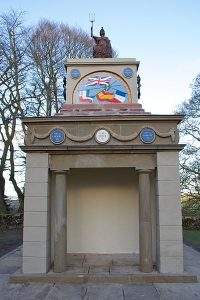- Author
- A.N. Other
- Subjects
- History - general, Biographies and personal histories
- Tags
-
- RAN Ships
- None noted.
- Publication
- September 2019 edition of the Naval Historical Review (all rights reserved)
This is a story of three men drawn together by the magnetism of a beautiful young artists’ model. Emma Hart, a country girl very much in the image of a latter day Eliza Doolittle portrayed in the musical My Fair Lady, became the mistress of the Honourable Charles Greville, a young rake who amused himself educating her. Emma then became the wife of his much older uncle Sir William Hamilton and ultimately the mistress of Admiral Lord Nelson.
Tria juncta in uno
The Treaty of Amiens had brought temporary peace to the traditional enemies Britain and France. Nelson, weary after his 1801 defeat of the Danes at Copenhagen, sought permission to haul down his flag and come ashore for some badly needed rest after many years at sea. Earlier in the year he had made the final break with his long suffering wife Frances, and his mistress Emma had enriched their lives with the birth of a daughter, Horatia. The Admiral, now well endowed with honours, looked forward to the peaceful pleasures of a county squire at Merton Place, the house he had recently acquired outside London, close to the village of Wimbledon. Here lived the ménage a trois of Lord Horiato Nelson, Lady Emma and Sir William Hamilton, famously known as the ‘Tria Juncta in Uno’ or ‘Three United in One,’ a whimsical reference to the motto of the Order of the Bath, worn by both male members of the trio.
By the spring of 1802 the aging Sir William, in his 73rd year, was complaining of Merton’s lifestyle with his young wife’s raucous parties, the constant stream of visitors and, of course, the expense, which Sir William shared with Lord Nelson. On the death of his first wife, a wealthy Pembrokeshire heiress, Sir William had inherited extensive estates in Wales. These were managed by his nephew and Emma’s former lover, the Hon. Charles Greville1, a younger son of the Earl of Warwick. As Sir William’s heir, Greville was instrumental in the proposed development of their lands at Milford Haven in ‘A Vision of Greatness’ as a naval dockyard to rival Plymouth. The persona of Nelson influencing the project could be a powerful factor affecting Government investment.
The Grand Tour
While Nelson had a personal dislike for young Greville for his alleged ill-treatment of Emma, he was persuaded to take a Grand Tour of the countryside which included Sir William’s Welsh estates. In the summer months it was not unusual for those with means to avoid the odours of big cities and escape to the country but the considerablejourney was not entirely for pleasure. The Admiral was also more than able to earn his keep on another far more important issue concerning the state of the fleet.

On Wednesday 21 July 1802 two heavily laden carriages departed Merton bound across the centre of England to the far west coast of Wales. They contained Sir William and Lady Hamilton, Lord Nelson, his brother, the Reverend William Nelson, Mrs Nelson and their son Horatio who was on holiday from school at Eton. Sir William’s manservant and Lord Nelson’s valet also accompanied the party and although not stated, it would be unusual for Lady Hamilton to have travelled without a maid. We are told of the need for endless changes of clothes as both Horiato and Emma were now the country’s greatest celebrities and ‘Dedicated Followers of Fashion’. Two coachmen were also required for the two pairs of four horses which required frequent changes throughout the journey. During the stage from Oxford to Gloucester the party was joined by the Admiral’s sister Kitty and her husband George Matcham.
The first stop was at Oxford where Lord Nelson was granted the freedom of the ‘city of dreaming spires’, and both he and his brother were awarded honorary doctorates by the famous university. On Saturday 24 July they arrived unheralded at nearby Blenheim Palace and, although his standard was flying, the Duke of Marlborough was pointedly not at home – more likely, His Grace felt unable to receive Lady Hamilton! After this setback spirits were again raised by the excellence of their reception with cheering crowds at all other venues during their sojourn.
After stopping at the cathedral city of Gloucester the party made for Ross-on-Wye. The course of the picturesque River Wye is heavily timbered on its eastern bank which abuts the Forest of Dean. The forest provided timber for ship-building and other industrial purposes. Here Nelson surveyed the deplorable state of the forest, much as Admiral John Byng2 had done when he had passed this way some years earlier. The Forest of Dean had a long history of iron making which in earlier times required a ready supply of timber for the production of charcoal to fuel furnaces. From the 1750s coking coal, which was in abundance in the nearby Welsh valleys, supplemented charcoal as furnace fuel.
From Ross-on-Wye the party preceded by boat down river to the ancient border market town of Monmouth and birthplace of Henry Tudor, Prince of Wales, later immortalised as Shakespeare’s Henry V. While well received, their stay was short having next to take the mountain road to Brecon and then to Merthyr Tydfil. At this time, in the early days of the Industrial Revolution, Merthyr had grown rapidly from a mere village to the largest town in Wales with a population in excess of 10,000, mostly employed by the iron works. Here they were entertained by Richard Crawshay, a new style of self-made industrialist with his Cyfarthfa Iron Works, by far the largest in the kingdom and possibly the world. Nelson wanted to see the mighty furnaces, which lit the night sky, and from whence came iron milled into cannons for HMS Victory and other great ships.
By 30 July the party had reached the county town of Carmarthen, staying at the Ivy Bush Hotel where the mayor and corporation held a civic reception in their honour. Later the visitors were entertained by a play performed at the local theatre.
Promoting Dockyard Development
The pace slackened as they reached Milford Haven in time for the celebrations on the first of August, commemorating the fourth anniversary of Nelson’s great triumph at the Battle of the Nile. In promoting the new town of Milford Haven the tourists were entertained at the ‘New Inn’, an establishment overlooking the waterway, which provided accommodation for passengers arriving and departing from the regular Irish packet, with a linking coach to major centres. The Admiral was introduced to all the local notables and spoke with enthusiasm at on the potential of this site as a future major dockyard, comparing Milford Haven with Trincomalee (Sri Lanka) as ‘the finest harbours he had ever seen3’.


Admiral Lord Nelson from a portrait by Leonard Guzzardi, and Emma Hamilton at the height of her beauty from a portrait by George Romney.
The Hamilton estates bordered the southern shores of Milford Haven, an extensive sheltered deep waterway leading to the Channel approaches. In 1757 the Admiralty conducted a survey of the Haven and recommended construction of a naval dockyard. This gave the green light to Sir William and his nephew to begin building a shipyard which they leased to Joseph Jacob. In an unusual arrangement the Admiralty contracted Jacob to build a frigate and later a 74 gun ship-of-the-line. When Jacob became insolvent in 1797 the Admiralty took over the lease and a total of seven naval ships was built here.
Charles Greville had also been busy and in 1792 persuaded seven leading American Quaker whaling families including those of Roth, Floger and Starbuck to relocate from Nantucket to Milford. These important families from the centre of the American whaling industry relocated to Wales to avoid punitive taxes placed on imported American goods following the War of Independence. Britain was at this time a major market for whale oil, mainly used to fuel street lighting in new urban and industrial areas.
Despite Nelson’s fulsome praise, negotiations between the Hamilton/Greville estates and the Admiralty dragged on over a number of years. In the end the Admiralty walked away and established a rival facility on land it had purchased on the opposite shore of the Haven. The new Royal Dockyard at Pembroke Dock launched its first ships in 1816. The ‘New Inn’ was renamed the ‘Lord Nelson Hotel’ and this still exists but little else eventuated to the benefit of the Hamilton/Greville dream of great developments and further riches.
They were also entertained by another great local landowner, Lord Cawdor at Stackpole Court. His lordship would have been able to regale Nelson with tales from the 1797 invasion of nearby Fishguard by a French force of 800 men seeking to inflame revolution amongst the Welsh. They were repulsed by the local militia, supported by 150 sailors with nine cannon taken from their ships, all under the command of Lord Cawdor.
On 7 August the return journey started, this time taking the easier coastal route and calling at picturesque Tenby, the bustling seaport of Swansea with its population of 7,000 making it the Principality’s second town. Swansea was then the copper capital of the world. All Nelson’s ships were copper sheathed to prevent teredo worms from boring into the wooden hulls. This also increased ship speed and manoeuvrability. During his visit he thanked the copper workers of Swansea for their skill. It was then onwards to Cardiff, the present day capital city of Wales, then a small town of 2,000 inhabitants. After crossing the muddy banks of the River Usk at Newport on 17 August they arrived at the old border town of Chepstow, guarded by its great Norman castle.
The Timber Industry
By the early 1800s first-rate ships such as Victory and Dreadnought which were refitting could not be completed for lack of specialist ‘compass oak4’ timber. This led the Admiralty to seek alternative sources of supplies from as far afield as New South Wales and New Zealand. Nelson visited the major dockyards where the emerging crisis was brought to his attention and he became concerned at the parlous state of the fleet through a great reduction in the availability of first rate ships5. It is not known if Nelson brought this matter up directly with the First Lord of the Admiralty, Lord St Vincent,as at this time their relationship was strained, owing to a disagreement over prize money, which was being litigated in the High Court.

Because of limited supplies, economy measures implemented by St Vincent, and strict inspection procedures of the Admiralty Timber Masters, stocks of home grown timber were nearing exhaustion. A cartel of major timber merchants, led by Bowsher, Hodges and Watkins of Chepstow, had written to the Admiralty on 20 January 1802 seeking improved commercial terms. Although the timber merchants were offered higher prices they failed to respond. At issue was the rigid method of receiving timber at the Dockyards. The merchants would rather sell into another market at a lower price than have every piece of timber cut and bored in search of defects and often rejected, resulting in considerable waste. While the reforming zeal of St Vincent was correct in principle, insisting that contract conditions and specifications were met, the uncompromising position led to a boycott by the cartel.
At Chepstow the Nelson party, heralded by a cheering crowd, stayed at the Three Cranes Inn, not far from the residence of John Bowsher. Bowsher, also a major in the local militia, met Nelson at the Three Cranes on the evening of 17 August. The conversation between the Admiral and merchant would have been interesting and while we have no knowledge of this they must have had a meaningful rapport and quickly came to an understanding that was acceptable to both parties. The outcome was certain with the immediate release of stocks. Less than a week later on 22 August a fleet of timber trows (barges) with attendant vessels sailed from Chepstow with cargoes of the best oak timber the Forest of Dean could supply. The voyage resulted in 781 loads of ‘compass oak’ being sent to Plymouth Dockyard and 490 loads to Portsmouth Dockyard. The cargoes were gratefully received and payment was promptly made. The commercial impasse had been broken and the dockyards could once again carry out building and repair work.
Monmouth Again
On 18 August 1802 the small market town of Monmouth was again aroused by the returning tourists. Here the party was feted by the local gentry at a beauty spot high above the town which has some of the finest vistas in Britain. Mysteriously this area known as ‘The Kymin’, situated many miles from the sea, has a naval temple devoted to Britain’s finest fighting admirals. The temple was dedicated by the Duchess of Beaufort, a daughter of Admiral (Old Dreadnought) Boscawen. Nelson was much impressed that such a tribute should be made by a small Welsh town which had no real seafaring connections, noting that this was the only monument (at that time) of its kind erected to the Royal Navy within the Kingdom. Here again Nelson continued showing interest and asking questions about the state of the nearby forest.
The evening entertainment was at the Beaufort Arms where they feasted on venison supplied by the estate of His Grace the Duke of Beaufort. The ‘Hero of the Nile’ gave a patriotic speech and in festive mood Emma led the singing of popular airs. A descriptive account of the visit was recorded by Charles Heath, a local bookseller, who gained permission from the Admiral to publish his speech.
Homeward Bound
Continuing on their homeward journey, the company was guests of Thomas Westfalings at Rudhall Manor, Ross-on-Wye from 20 to 22 August. From here Nelson completed an eleven page draft report of his findings on the poor state of the forest. The document was written with his left hand and only contains one full stop but there is a plentiful supply of commas. A grammatical fair copy was produced for the Admiralty by a secretary after return to Merton. In part this report reads: I am informed if in a state of high cultivation oak would produce 9,200 loads of timber fit for ships of the line every year. This is further qualified, stating: Nothing in it can grow self-sown, for the deer bark all the young trees. Vast droves of hogs are allowed to go into the woods in the autumn, and if any fortunate acorns escapes their search, and take root, then flocks of sheep are allows into the forest, and they bite off the tender shoot.’ He also speaks of miners having the right to dig for coal and many more problems leading to mismanagement of this valuable timber resource. It appears the Admiral’s report was well received and was instrumental to the Admiralty seeking improvements in later forestry management regimes.
During the final leg of the journey visits were made to two more cathedral cities, Hereford and Worcester, the former known for cider and perry, of which supplies were purchased to be loaded on the by now groaning carriages and at the latter, known for its fine chinaware, settings were commissioned with the Nelson coat of arms. At Birmingham more visits were made to new manufacturing centres. A further call was made to Warwick Castle where Sir William’s sister Elizabeth was Countess. The final stop was at Althorp, home of Earl Spencer, a former First Lord of the Admiralty who helped guide Nelson’s early career. Of more recent times this was also the home of the late Diana, Princess of Wales. The party returned to Merton Place on Sunday 5 September 1802 after a journey of 45 days. Nelson’s valet must have been a promising accountant as we have precise details of the cost of the Grand Tour at £481/3/10; using wage indexing, about $AU1,000,000 at today’s (2018) prices, with the costs shared equally between the Admiral and Sir William.
Sir William Hamilton died in April 1803 and his body was to make one more lonely journey back to Pembrokeshire to be buried next to his first wife Katherine. The following month war again broke out with France. Nelson was once again called upon, this time as Commander in Chief of the Mediterranean Fleet, a position he would hold until his untimely death a little more than two years later.
Finale
Through copious volumes we know much of the life of this brilliant fighting admiral. His health has been minutely examined, we know possibly far too much of an unfortunate family life, and even details of his financial difficulties. This story however shows another important dimension to this most complex individual. Here he again turns a blind eye to bureaucracy and seeks opportunities to resolve vital issues outside his remit that seriously impacted future operational capabilities. If Nelson had not been so committed during a seemingly pleasant sojourn to the countryside the fleet would have not been in a fit state to win him his ultimate great victory at Trafalgar.
As for the ‘Vision of Greatness’ at Milford Haven, this did partially come to fruition many years later thanks to Gamal Nasser’s 1956 nationalisation of the Suez Canal which curtailed Britain’s vital Middle East oil supplies requiring them to be shipped over much greater distances around the Cape of Good Hope. The economics called for super tankers and deep-water harbours for discharge. This resulted in Milford Haven for a number of years becoming, in tonnage, Britain’s largest port linked to adjacent oil refineries.
Notes:
1 The Hon. Charles Francis Greville was Member of Parliament for Warwick and held a number of government appointments. He was well educated and had a keen interest in antiquities and horticulture. In the latter endeavour he was a close friend of Sir Joseph Banks and the Australian plant genus Grevillea is named in his honour.
2 Admiral John Byng was tried by court-martial for failing to relieve a garrison being besieged by a French Fleet during the Battle of Minorca. He was sentenced to death and shot by a firing squad in HMS Monarch on 14 March 1757.
3 Nelson visited Ceylon in 1770 when serving as a Midshipman in HMS Seahorse – he referred to Trincomalee as ‘the finest harbour in the world’.
4 Compass timbers (Smyth 1867) – ‘such as were curved, crooked, or arched for ship building’.
5 It has been estimated that the construction of a three deck ship-of-the-line called for 3,500 fully grown oak trees requiring 900 acres of forest. It took about 100 years for a tree to reach maturity.
Bibliography
Baker, Mike, Lord Nelson and John Bowsher, South West Soundings No 46, October 1991, The South West Maritime History Society. – see also Mariners Mirror Vol 86, Issue 3, 2000.
Downer, Martyn, Nelson’s Purse, London: Bantam Press, 2004.
Gill, Edward, Nelson and the Hamiltons on Tour, Gloucester: Alan Sutton Publishing, 1987.
Hando, Fred J., Journeys in Gwent, Newport, Mon: R.H. Johns Limited, 1951.
Heath, Charles, Proud Days for Monmouth, Monmouth: Charles Heath, 1802 – facsimile edition with additions published by the Nelson Museum & Local History Centre, Monmouth, 2002.
Pool, Bernard, Naval Board Contracts 1660-1832, London: Longmans, 1966.
Nicholls, H.G., The Forest of Dean, An Historical & Descriptive Account, etc., London: John Murray, 1858.
McKay, K.D., A Vision of Greatness – the History of Milford 1790-1990. Haverfordwest, Wales: Brace Harvatt Associates, 1989.
Mercier, Hugo, The Pursuit of Victory: The Life and Achievements of Horatio Nelson, London: Penguin, 2006.
Smyth, Admiral W. H., Sailor’s Word Book – An Alphabetical Digest of Nautical Terms, London: Blackie & Sons, 1867.




